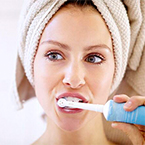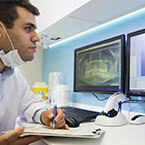Dental X-Rays: How They Work & When to Get Them

Table of Contents
How Dental X-Rays Work
When the X-rays pass through the mouth, the teeth and bones absorb more of the ray than the gums and soft tissues, so the teeth appear lighter on the final X-ray image (called a radiograph). Areas of tooth decay and infection look darker because they don’t absorb as much of the X-ray.
How Often Should Dental X-Rays Be Taken?
How often you need dental X-rays depends on your particular oral health. But if you’re prone to tooth decay, your dental professional may recommend dental X-rays annually to identify weak spots and treat them before the decay progresses. Children and teens may need X-rays more often than adults because their teeth and jaws aren’t yet fully developed. Also, your dental professional will take X-rays before a procedure such as a root canal or tooth extraction.
There are several other situations that might require dental X-rays. If you switch to a new dental professional, they may want to take X-rays to help them become more familiar with your teeth and any problems that you have. A new dental professional might also ask your previous dental professional to send any old X-rays in order to have a complete history of your dental care.
What Do Dental X-Rays Show?
The images taken from dental X-rays provide your dental professional with valuable information about your teeth and gums and help him or her plan the best treatment for any problems that you have. Dental professionals can also use the information from an X-ray to identify infections, abscesses and even small cysts and tumors. X-rays can even help identify developmental abnormalities, such as impacted wisdom teeth.
The appearance of fillings and crowns on an X-ray depends on what they are made of. Some appear dark and some appear light. No matter what type of dental restoration or implant you have, your dental professional can use X-rays to help identify any areas that need attention or adjustment.
Dental X-Ray Radiation: Are Dental X-Rays Safe?
Of course, the machines used for dental X-rays do involve radiation, but the amount of exposure is extremely small, which is why studies have shown that dental X-rays are safe for most people in most situations.
In fact, measurements of the radiation in dental X-rays show that they are not significantly different from the radiation most people are exposed to in daily life from environmental influences. These might include frequent travel by airplane and certain appliances in the home, such as TV sets and smoke detectors.
Dental X-Ray While Pregnant
Although the amount of radiation in dental X-rays is quite low and the procedure is safe, pregnant women should refrain from dental X-rays unless they are necessary. But because pregnant women are at increased risk for gum disease, it’s important not to ignore a potentially serious dental problem due to fears about radiation exposure from X-rays. If you are pregnant and you require dental X-rays, your dental professional will have you wear a lead apron and a lead thyroid collar to protect vulnerable areas. In fact, children and women of childbearing age should wear protective lead coverings when getting dental X-rays. But there is no added risk associated with dental X-rays for breastfeeding women or women who are trying to become pregnant.
Table of Contents
- How Dental X-Rays Work
- How Often Should Dental X-Rays Be Taken?
- What Do Dental X-Rays Show?
- Dental X-Ray Radiation: Are Dental X-Rays Safe?
- Dental X-Ray While Pregnant
-
- Related Articles

Sign Up
for expert advice and exclusive offers

Sign Up
for expert advice and exclusive offers





